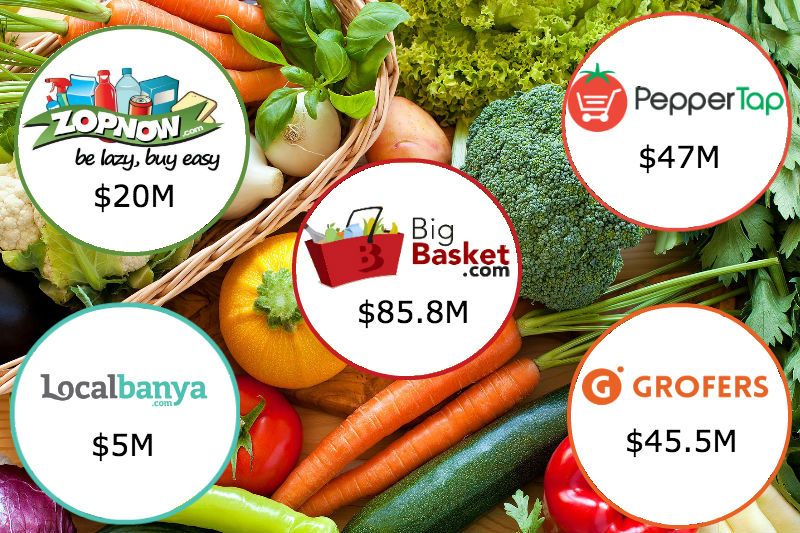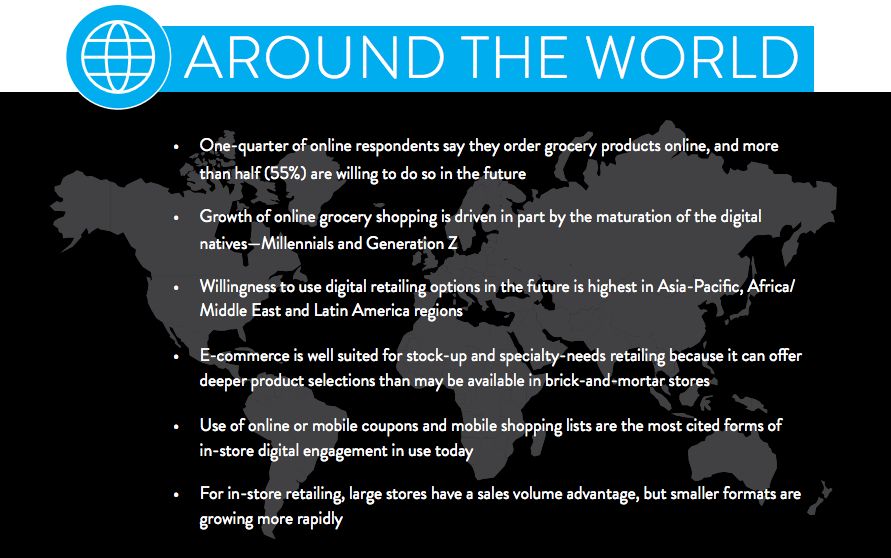Grocery eCommerce Scenario in India: Overcoming Challenges, Competition and Threats
The year 2015 started with a plethora of investments happening in the ‘hyper local’ space, be it food delivery, home services or logistics. On the same front, a number of new grocery delivery firms were also seen sprouting and scaling up. The veterans in this space BigBasket, ZopNow etc. too garnered attention from VC investors. However, the autumn of this year is proving to be cold for several startups as they struggle with funding challenges, can grocery delivery companies fare any better?
With increasing penetration of Internet connectivity (rise of smartphone users), growing popularity of mobile shopping, and dealing in daily consumption commodities, grocery e-stores do hold a potential in India. The market share is estimated to be less than $100 million at present, but is expected to cross $25 billion by 2020, expected to grow at a rate of 25-30% year-on-year in major Indian cities, as predicted by retail consultancy Technopak.
According to Ken Research report, Indian online groceries market is envisaged to grow and reach Rs 2.7 billion by FY’2019. There are roughly 25 odd companies in this space that have received and announced external funding in 2015. The top 5 startups that have raised maximum funding among these are shown below.

Top 5 Grocery Startups in Terms of Funding Raised
A few acquisitions have been seen in this space this year, such as BigZop getting acquired by AutonCab, Grofers acquiring Mygreenbox.
The first firms who came up in the online grocery sale segment were formed in 2011, and since then this has been a growing industry in India. In February 2015, the share of BigBasket was the largest among the online grocery businesses, followed by Zopnow as reported by Ken Research.
While the space does holds a good opportunity, it still hasn’t been easy to crack. Even the funded startups struggle to scale up. There are challenges in different areas of operations – Technology, vendors, logistics and more.
Different companies in the same space have experimented with different models for order fulfilment. BigBasket has an inventory-led model with its own logistics and supply chain network, Grofers and Peppertap have tied up with local stores in cities for enabling hyper local deliveries, Aaramshop has a hybrid model where consumers can order online and receive from one of its nearby stores. Additionally, to add further competition for these companies, mainstream retailer Future Group will launch Big Bazaar app for grocery ordering.
Where do the roadblocks lie?
Challenges faced by grocery delivery startups are multiple ranging from maintaining quality of their products to managing the inventory to logistics to customer satisfaction and retention to even fundraising. These niche businesses also have requirements of the right talent for vendor acquisition and fulfilment, especially for those who are not keeping their own inventory, tapping into the right local stores for supply is a critical but a tough task.
“While tying up with a merchant as a partner, the poor quality of data and regulated MRP’s limiting our margins are some challenges. The delivery staff at times is technophobic but we are constantly working towards easing out these challenges.” says Navneet Singh, Co-Founder and CEO at Peppertap.
For Saurabh Kumar, Founder at Grofers, the biggest challenge was to find the right talent for their team which would align with the vision of the company and help it grow. His company is backed by Tiger Global and Sequoia Capital, and is in discussions with other tech VC firms like Softbank and DST Global to raise more money.
Meanwhile, Rashi Choudhary, Co-Founder and COO at LocalBanya opined that raising an investment to fuel the growth and expansion of the company was a tough part for her firm. Further, she feels that this kind of business has many vital parts that must work together well and it takes a lot of planning and smart thinking to pull it off. Localbanya had recently shut down its operations temporarily and laid off a sizeable amount of its workforce.
Vijay Singh, MD and CEO, Aaramshop finds staying in tune with the consumer behaviour as the biggest challenge. “We are firm believers that the shopping behaviour of consumers would continue to be multi-channel, however, the consumers’ habit of standing in a queue to shop for groceries stays our biggest competitor.” says Vijay. “The growth in mobile has prompted us to look at mobile app far more seriously than we were doing last year.” he added. He had started the company back in 2011, and has been successfully bootstrapping it since then.
When we raised the same question to a recently launched startup LazyLad, its Co-founder Saurabh Singla said, “There is an issue of adaptability with some retailers. Some are very open to the use of technology to enhance their business, but few of the retailers are quite skeptical about this.”
All the companies appear to be facing issues on different fronts, this is owing to the different models that these firms operate in. However, Vipul Parekh, Co-Founder at BigBasket sums it well for us when he says that merchandising, logistics, people management and technology are four key areas of challenge for a grocery delivery firm. Delivering grocery products with varying shelf lives in a large geographical area along with managing the inventory is crucial so as to provide hill fill rate to the customers. Recruiting, training, managing and motivating the blue-collar workforce of the logistics team is another significant challenge in this line of business.
Competing and Standing Out

Founders of the grocery eCommerce companies who spoke their mind
Hands down, all grocery eCommerce companies agree that the market itself needs to be tamed first. Even though a number of parameters are in favour of eCommerce in general like increasing Internet penetration, smartphone users, online shoppers, logistics support and so on, grocery remains a vertical that requires special treatment due to the perishable nature of the inventory. Moreover, with India having multiple grocery stores in or near every neighbourhood, a majority of the population doesn’t have to go far for its daily grocery requirements.
Vipul from BigBasket says, “At this point in time physical grocery stores would be our biggest competition and within them the large chains would take preeminence.” The large chains mentioned here, such as BigBazaar, Nature’s Basket and so on are moving into a hybrid model as they continue to expand their offline presence. They have more leverage over the pure play grocery eCommerce/delivery ventures owing to their brand name and profitable parent firms.
In order to create a differentiating factor among themselves, the companies are gunning for a consumer first approach. These firms are working on the technology backend and optimising the supply chain to better their competitors. BigBasket takes pride on its inventory of 14,000 SKUs, Peppertap states its under 2 hour delivery as its USP. “As this market picks up steam, there are various players that are making an entry with different business models. There is room to experiment and given various factors such as location, capital and technology, we will continue to see this occur,” says Rashi from LocalBanya.
Walking Among the Giants?
It has to be noted that the existing horizontal marketplaces also see grocery as a viable space. Amazon has been dealing in gourmet food products for some time now. Flipkart is also rumoured to have plans for launching grocery delivery this year. Snapdeal tied up with Godrej Nature Basket at the beginning of 2015 to foray into this vertical. Paytm had launched a dedicated app for grocery ordering in April 2015, however not much was heard of it thereafter and it was taken down from the app store in the following June.
When asked if the niche companies should feel threatened about this trend in the market, Vipul from BigBasket said, “This is different market from General Merchandise in terms of supply chain, logistics and domain knowledge requirements to handle the category well. As a result it is not an easy decision to launch grocery. I think it will take them time and effort to develop a model which works and to compete effectively. Having said that, this is a large retail category and with their growth aspirations I would not be surprised if they chose to enter this domain in some form or the other. I think their entry into the market will make the domain more competitive but will also expand the online market for grocery significantly. In the long run this will be significantly beneficial to leaders in the space like us.”
Navneet Singh, CEO and Founder at Peppertap feels that with the entry of these players in this space, the market will see a lot of momentum. Quoting him, “It will be interesting to see if these giants get into a price war or adopt a different strategy for customer acquisition. Online grocery soon will become one of the top three most attractive segment for online retailers after electronics and apparel.”
Lazylad’s Co-Founder Saurabh Singla feels that entry of Amazon, Flipkart and Snapdeal into this space provides validation to the model. It ensures that the market is hot and the customers buying tendency is more from mobile. Further he adds, “The trend is changing and there is a huge opportunity out there and a lot of innovation to be done to overcome the problems in the sector which are very easy for a startup to tackle and difficult for an established player to handle due to the inherent difference between the two.”
The niche players appear to be confident about capturing the market even post the entry of eCommerce marketplaces in the segment owing to their vertical focus.
The Way Forward
While Indian eCommerce in general is often compared to that of US and China, stacking it up in this segment might give contrary results. According to a report by Nielsen, APAC is the hottest area for grocery eCommerce.

Source: Nielsen E-commerce and the New Retail Survey, Q3 2014
Consumers in Asia Pacific region are most willing to buy groceries online as per the survey conducted by Nielsen. This trend was also seen in the likelihood to opt for subscription eCommerce, and ordering online and picking up at a store. Besides those who are already operating in a hybrid model, it might make sense for companies to indeed go hyperlocal with either their own inventory or through reliable partner stores.
It is unlikely that these companies will replace the brick and mortar stores, however the trend of on-demand grocery delivery might catch up as the Millennials mature. The companies would need to develop intelligence around what inventory to keep and how much.
Customer experience needs to be the top priority for these companies – across technology, delivery and service – since convenience would be the primary reason, consumers will switch to buying digitally. And this would be where they can get an edge over their competitors. Given to the capital intensive nature of this model for scaling up fast, only the fittest would survive.
Continue reading here: Mobile UX Design: Where You Are Making Mistakes and How to Avoid Them?
Was this article helpful?
Readers' Questions
-
Felix1 year ago
- Reply

